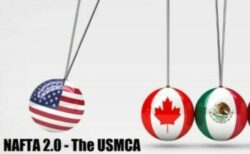By: Paul Fudacz, Senior Associate Attorney
With the advent of the Section 301 tariffs, an issue that has been raised frequently is how to accurately determine the country of origin for Section 301 tariff purposes for goods imported from a NAFTA country. The NAFTA sets forth rules for determining the “country of origin” of products traded within the NAFTA territory under 19 CFR Section 102. However, these rules are applicable for two basic purposes – the first is to determine the country of origin for customs marking purposes, and the second is to determine whether a product is eligible for NAFTA treatment (this analysis is different from that to determine whether a product “qualifies” for the NAFTA duty preference however).
Section 102 (19 C.F.R. Part 102), provides a required hierarchy for determining the country of origin for marking and general eligibility purposes. Applied in sequential order, the required hierarchy establishes that the country of origin of a good is the country in which:
(a)(1) The good is wholly obtained or produced;
(a)(2) The good is produced exclusively from domestic materials; or
(a)(3) Each foreign material incorporated in that good undergoes an applicable change in tariff classification set out in Section 102.20, and satisfies any other applicable requirements of that section, and all other applicable requirements of these rules are satisfied.
In most cases where multiple non-NAFTA inputs are involved, rule (a)(3) applies requiring a change in tariff classification of the input components and materials as a result of further processing or manufacturing in Mexico or Canada. If the criteria is met, then the product meets the HTSUS Special Program Indicator (SPI) criteria (“MX” for Mexican goods, “CA” for Canadian goods) and can be considered for the NAFTA duty preference. This does not mean the goods “qualify”, but only that they are eligible. A separate analysis is required applying the NAFTA Rules of Origin to determine if the products indeed qualify for the NAFTA duty preference (usually this analysis would be done prior to embarking on the country of origin marking analysis).
In addition to establishing NAFTA general eligibility, Section 102 also establishes the country of origin for NAFTA marking purposes, i.e., whether the product should be marked to indicate Mexican, Canadian, or the country of origin of the components, should the tariff shift criteria not be met.
However, when considering a product that may be subject to safeguard measures, such as Section 301, the substantial transformation analysis is applied to determine the country of origin. See 19 C.F.R. § 102.0; HQ 563205, dated June 28, 2006; see also Belcrest Linens v. United States, 741 F.2d 1368, 1370-71 (Fed. Cir. 1984). Under 19 CFR 134.1(b), “country of origin” means the country of manufacture, production, or growth of any article of foreign origin entering the United States. Further work or material added to an article in another country must effect a substantial transformation in order to render such other country the “country of origin.”
Further, pursuant to 19 CFR 10.14(b), a substantial transformation of materials or components occurs when they are used in the manufacture of a product having a name, character, or use differing from that of the imported article. However, if the manufacturing or combining process is a minor one, which leaves the identity of the imported article intact, this will not result in a substantial transformation. For this reason, assembly operations which are minimal or simple, as opposed to complex or meaningful, will generally not result in a substantial transformation.
Therefore, when performing an analysis related to goods produced in Canada or Mexico when there are Chinese inputs, two different scenarios must be examined. The first is under Section 102 to determine the country of origin for NAFTA purposes, and the second is to determine the country of origin for Section 301 purposes using the substantial transformation test. A substantial transformation analysis is by nature an inherently fact specific exercise and is generally determined on a case-by-case-basis. As the stakes can be very high when performing this analysis to determine whether Section 301 tariffs are applicable, unless the facts are quite clear-cut and the “reasonable care” standard can be met without question, then importers are encouraged to seek a formal country of origin ruling from CBP in order to determine the final country of origin.

